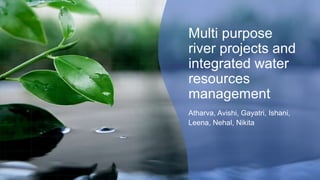Document from Ishani.pptx
•Download as PPTX, PDF•
0 likes•4 views
Multi purpose river project
Report
Share
Report
Share

Recommended
Recommended
More Related Content
Similar to Document from Ishani.pptx
Similar to Document from Ishani.pptx (20)
Chapter - 3, Water Resources, Geography, Social Science, Class 10

Chapter - 3, Water Resources, Geography, Social Science, Class 10
chapter3geography10th-210708005511_230609_161414.pdf

chapter3geography10th-210708005511_230609_161414.pdf
Water resources. its depletion and its conservation

Water resources. its depletion and its conservation
Recently uploaded
Recently uploaded (20)
GUIDELINES ON SIMILAR BIOLOGICS Regulatory Requirements for Marketing Authori...

GUIDELINES ON SIMILAR BIOLOGICS Regulatory Requirements for Marketing Authori...
Recombination DNA Technology (Nucleic Acid Hybridization )

Recombination DNA Technology (Nucleic Acid Hybridization )
Biopesticide (2).pptx .This slides helps to know the different types of biop...

Biopesticide (2).pptx .This slides helps to know the different types of biop...
Creating and Analyzing Definitive Screening Designs

Creating and Analyzing Definitive Screening Designs
TEST BANK For Radiologic Science for Technologists, 12th Edition by Stewart C...

TEST BANK For Radiologic Science for Technologists, 12th Edition by Stewart C...
Asymmetry in the atmosphere of the ultra-hot Jupiter WASP-76 b

Asymmetry in the atmosphere of the ultra-hot Jupiter WASP-76 b
Biogenic Sulfur Gases as Biosignatures on Temperate Sub-Neptune Waterworlds

Biogenic Sulfur Gases as Biosignatures on Temperate Sub-Neptune Waterworlds
Recombinant DNA technology (Immunological screening)

Recombinant DNA technology (Immunological screening)
High Class Escorts in Hyderabad ₹7.5k Pick Up & Drop With Cash Payment 969456...

High Class Escorts in Hyderabad ₹7.5k Pick Up & Drop With Cash Payment 969456...
Chemical Tests; flame test, positive and negative ions test Edexcel Internati...

Chemical Tests; flame test, positive and negative ions test Edexcel Internati...
Document from Ishani.pptx
- 1. Multi purpose river projects and integrated water resources management Atharva, Avishi, Gayatri, Ishani, Leena, Nehal, Nikita
- 2. Building hydraulic structures • A commonly adapted solution for water conservation going way back to the first century BCE This Photo by Unknown Author is licensed under CC BY-SA
- 3. History and Hydraulic Constructions • 1st Century BCE- Sringaverapura, Andhra Pradesh • Water harvesting system • Comprises three percolation-cum-storage tanks, fed by an 11 m wide and 5 m deep canal that used to skim the floodwaters off the Ganga. • Water from the canal first entered a silting chamber where the dirt settled. This relatively clean water was then directed to the first brick- lined tank (Tank A), then through a stepped inlet (which cleaned the water further) on to Tank B. This tank constituted the primary source of water supply. Next, the water passed to a circular Tank C, which had an elaborate staircase. An elaborate waste weir, consisting of seven spill channels, a crest, and a final exit, ensured that the excess water flowed back into the Ganga.
- 4. Other historical evidences 321-297 BCE Chandragupta Maurya’s reign: Dams, irrigation systems etc. 11th Century the Bhopal Lake 14th Century Sultan Iltutmish, in Haus Khas, Delhi
- 5. DAMS Spillway: created to ensure that excess water, if accumulated, can be emptied thereby not degrading the dam itself Material used: - Timber dams - Embankment dams - Mansory dams Height: - Large/Major dams - Low dams - Medium height dams - High dams
- 6. Uses of Dams Electricity generation (hydropower) Irrigation/ Domestic water supply Flood control, inland navigation Fish breeding, Recreation
- 7. DAMS AND CONFLICT • Construction of a dam requires major displacement of people around it • Displacement => livelihoods lost • Deforestation and pollution
- 9. Regulating flow of water results in poor sediment flow
- 10. 1. THIS MAY ALSO LEAD TO EXCESSIVE SEDIMENTATION MAKING THE RIVER BEDS ROCKIER AND POOR HABITATS FOR AQUATIC LIFE. • DAMS FRAGMENT RIVERS MAKING IT HARD FOR AQUATIC ANIMALS TO MIGRATE.
- 11. • SINCE WATER IS AVAILABLE IN LARGE QUANTITIES, FARMERS GROW WATER INTENSIVE CROPS. • THIS CHANGE IN CROPPING AND IRRIAGTION LEADS TO SALINISATION OF SOIL.
- 12. 1. IT ALSO SUBMERGES VEGETATION LEADING TO SOIL DEGRADATION
- 13. 1. BIG DAMS THAT HAVE BEEN CONSTRUCTED TO RESTRICT FLOODS HAVE FAILED TO DO SO BECAUSE OF EXCESSIVE SEDIMENTATION. • EG- MAHARASHTRA AND GUJRAT (2006)
- 14. SOCIAL REASONS 1. A SOCIAL REASON ASSOCIATED WITH THE OPPOSION IS THAT A LARGE AMOUNT OF LOCALS GET DISPLACED FROM THEIR HOMES AND VILLAGES.
- 15. • IT INCREASE THE GAP BETWEEN THE RICH LANDLORDS AND THE LANDLESS POOR, THUS LEADING TO SOCIAL CONFLICTS.
- 17. • THE BUILDING OF THE SARDAR SAROVAR DAM WAS MUCH DISPUTED BECAUSE ENVIRONMENTALISTS BELIEVED IT WOULD SUBMERGE COUNTLESS TREES. • THIS LED TO THE NARMADA BACHAO ANDOLAN, WHICH WAS ORGANISED BY A NGO AGAINST THE CONSTRUCTION OF THE DAM. • EVEN AFTER IT’S CONSTRUCTION, FARMERS ALMOST CAUSED A RIOT BECAUSE OF THE PREFERENCE GIVEN TO URBAN AREAS FOR MORE WATER SUPPLY
- 18. Thank You!
Editor's Notes
- 1- embankment, 2- dam, 3-reservoir, 4-canal
- 1- Dams, lakes, irrigation systems 2-
- Act as a barrier for flowing water Block or retard water flow Jawaharlal Nehru proudly proclaimed the dams as the ‘temples of modern India’; the reason being that it would integrate development of agriculture and the village economy with rapid industrialisation and growth of the urban economy.